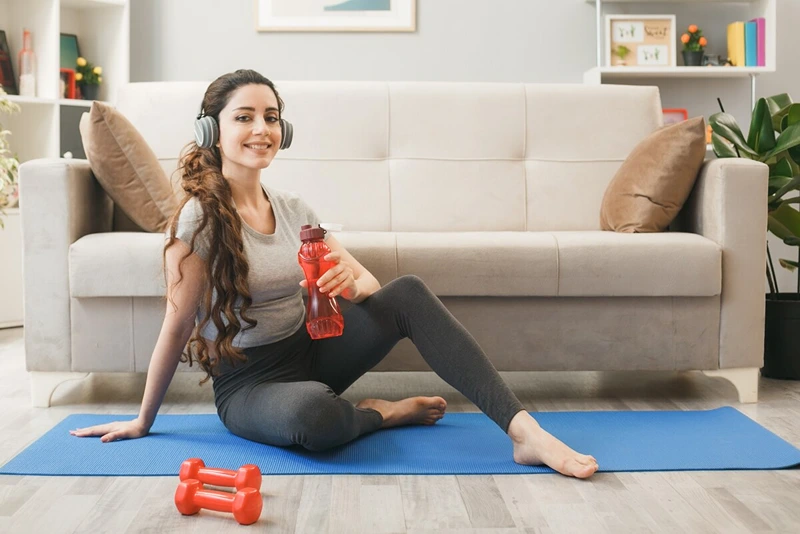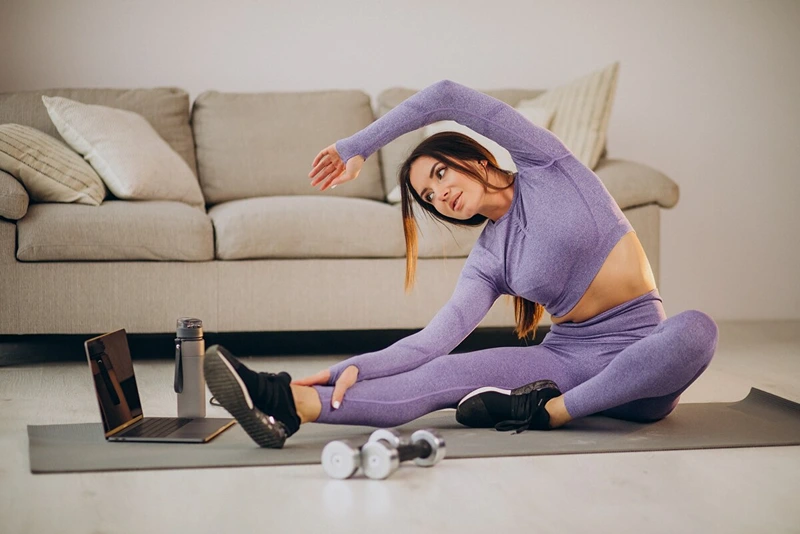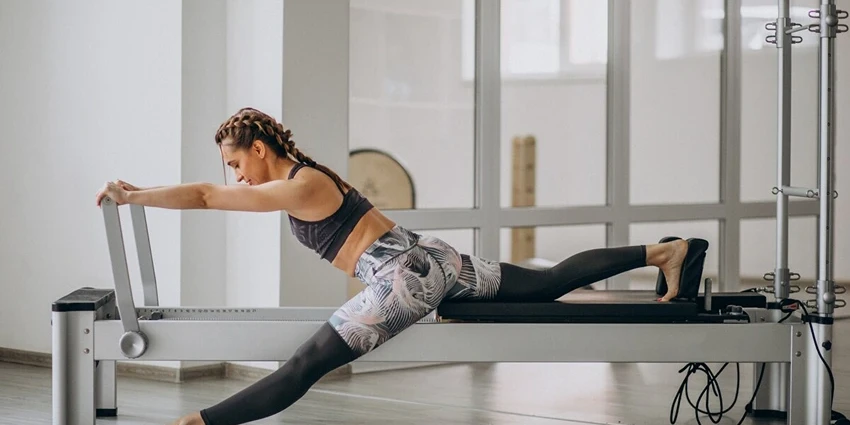At Rac Women, we believe in the power of strength, resilience, and the convenience of achieving fitness goals within your personal sanctuary. Home strength routines are not just a trend; they are a lifestyle shift that empowers you to take charge of your health on your terms.
In This Article
Establishing Your Home Workout Space
Creating a dedicated space for your workouts can transform your home into a sanctuary of strength. It doesn’t require a lot of space or fancy equipment; just a corner with enough room to move freely can be your gym.
Choosing the Right Space
- Ventilation: Ensure good airflow for comfort and health.
- Lighting: Bright lighting can boost energy and mood.
- Privacy: A private space helps maintain focus and reduce interruptions.
Essential Equipment for Home Strength Routines
- Resistance Bands: Versatile and space-saving for strength training.
- Yoga Mat: Provides cushioning and grip for floor exercises.
- Dumbbells: Adjustable weights can enhance your workout variety.

Warming Up: The Foundation of Effective Training
A proper warm-up prepares your body for the demands of strength training, reducing the risk of injury and improving performance.
Simple Warm-Up Exercises
- Jogging in Place: Increases heart rate and warms up the body.
- Arm Circles: Loosens the shoulders and prepares the upper body for exercise.
- Leg Swings: Enhances leg flexibility and mobility.
Bodyweight Exercises: The Core of Home Strength
Bodyweight exercises are the pillars of home strength routines, requiring no equipment while still offering a full-body workout.
Push-Ups and Variations
- Standard Push-Up: Builds upper body and core strength.
- Incline Push-Up: A beginner-friendly variation that reduces the intensity.
Squats and Variations
- Bodyweight Squat: Engages the core, glutes, and legs.
- Sumo Squat: Targets inner thighs and glutes with a wider stance.
Lunges and Variations
- Forward Lunge: Strengthens legs and improves balance.
- Reverse Lunge: Puts less stress on the knees, suitable for beginners.
Planks and Core Exercises
- Forearm Plank: A fundamental core-strengthening exercise.
- Side Plank: Challenges the obliques and stabilizes the core.
Resistance Training: Enhancing Strength at Home
Incorporating resistance into your home workouts can significantly improve muscle strength and endurance.
Using Household Items for Resistance
- Water Bottles: Can be used as makeshift dumbbells for light resistance.
- Backpacks: Fill with books for a customizable weight for squats or lunges.
Resistance Band Exercises
- Banded Pull-Aparts: Great for the back and shoulder health.
- Banded Squats: Adds resistance to squats for increased intensity.
Safe Lifting Techniques
- Keep a Neutral Spine: Prevents back injuries during lifting.
- Engage Your Core: Provides stability and power for all exercises.
High-Intensity Interval Training (HIIT) for Building Strength
HIIT combines short bursts of intense exercise with periods of rest or lower-intensity exercise, making it perfect for home workouts.
Explanation of HIIT
- Efficiency: HIIT can deliver results in a shorter time frame.
- Adaptability: Can be modified for any fitness level and space.
Sample HIIT Routines for Strength
- Tabata Protocol: 20 seconds of work followed by 10 seconds of rest, repeated 8 times.
- Circuit Training: A series of exercises performed back to back with minimal rest.
Recovery and Cool Down: Essential for Home Strength Success
Cooling down after a workout is as crucial as the exercise itself, aiding in recovery and reducing muscle soreness.
Stretching and Flexibility
- Static Stretches: Hold each stretch for at least 30 seconds for effectiveness.
- Yoga Poses: Incorporate poses like Child’s Pose and Downward Dog for relaxation.
Importance of Rest Days
- Muscle Repair: Rest allows muscles to repair and grow stronger.
- Prevent Burnout: Regular rest can prevent mental and physical fatigue.
Nutrition and Strength Training: Fueling Your Home Workouts
Proper nutrition is the backbone of any strength training routine, providing the energy and building blocks for muscle growth.
Basic Nutrition Tips for Strength Training
- Protein: Essential for muscle repair and growth.
- Carbohydrates: Provides energy for high-intensity workouts.
Supplements for Muscle Growth
- Whey Protein: A convenient way to increase your daily protein intake.
- Creatine: Can improve strength and lean muscle mass.
Maximizing Home Workouts: Advanced Techniques and Strategies
Taking your home strength routines to the next level requires incorporating advanced techniques that challenge your muscles and enhance your endurance.
Progressive Overload
- Gradually Increase Weight: Add more resistance to keep challenging your muscles.
- Increase Repetitions: Do more reps with the same weight to build endurance.
Time Under Tension (TUT)
- Slow Down Reps: Perform exercises more slowly to increase muscle strain.
- Pause at Peak Contraction: Hold the position where the muscle is fully engaged.
Supersets and Compound Sets
- Supersets: Alternate between two different exercises with no rest in between.
- Compound Sets: Perform two exercises for the same muscle group back-to-back.

Staying Motivated: Keeping Your Home Workouts Fresh
To maintain enthusiasm for your home workouts, it’s important to keep them varied and interesting.
Mixing Up Your Routine
- Try New Exercises: Prevents boredom and targets different muscle groups.
- Change Your Workout Structure: Switch between circuits, supersets, and traditional sets.
Setting and Tracking Goals
- Short-Term Milestones: Keeps you motivated with achievable targets.
- Long-Term Objectives: Provides a vision for your fitness journey.

Community and Support: The Role of Social Interaction in Home Workouts
Even when working out from home, a sense of community can provide motivation and accountability.
Virtual Workout Buddies
- Online Fitness Communities: Share tips, progress, and encouragement.
- Virtual Workout Sessions: Join live-streamed classes or workout with friends over video.
Social Media Challenges
- Participate in Challenges: Engage with fitness challenges on social media platforms.
- Share Your Progress: Posting your workouts can lead to support and motivation from peers.
Frequently Asked Questions (FAQs)
Here are some common questions about home strength routines, answered by our experts at Rac Women.
The best strength exercises you can do at home include push-ups, squats, lunges, planks, and burpees. They require no equipment and can be modified to increase difficulty.
Aim for at least 2-3 times per week, allowing for a day of rest between sessions to let your muscles recover.
Absolutely! With proper technique, progressive overload, and a balanced diet, you can build muscle effectively at home.
Tables of Useful Information
Bodyweight Exercise Progressions
| Exercise | Beginner | Intermediate | Advanced |
|---|---|---|---|
| Push-Up | Wall Push-Up | Standard Push-Up | Decline Push-Up |
| Squat | Chair Squat | Bodyweight Squat | Pistol Squat |
| Lunge | Assisted Lunge | Forward Lunge | Jumping Lunge |
| Plank | Knee Plank | Forearm Plank | Plank with Leg Lift |
Home Workout Equipment Alternatives
| Traditional Equipment | Home Alternative |
|---|---|
| Dumbbells | Water Bottles |
| Kettlebell | Heavy Book Bag |
| Bench | Sturdy Chair |
| Pull-Up Bar | Door Frame |
Weekly Home Workout Plan
| Day | Workout Focus | Exercise Examples |
|---|---|---|
| Monday | Upper Body | Push-Ups, Dumbbell Rows |
| Wednesday | Lower Body | Squats, Lunges |
| Friday | Full Body | Burpees, Plank |
Ellen Crandall
Meet Ellen, your fitness compass in the world of athletics, training, and gym culture. With a commitment to well-being and a penchant for all things workout-related, Ellen is here to guide you on your journey to a healthier, fitter you. Join the fitness revolution, led by Ellen, and embrace the power of an active lifestyle.




